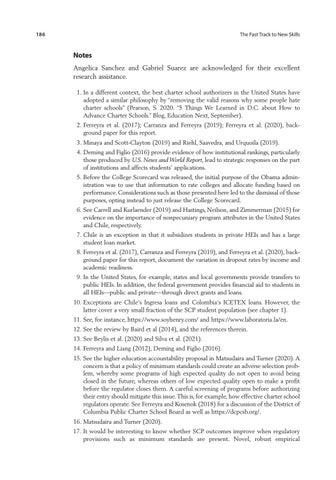186
The Fast Track to New Skills
Notes Angelica Sanchez and Gabriel Suarez are acknowledged for their excellent research assistance. 1. In a different context, the best charter school authorizers in the United States have adopted a similar philosophy by “removing the valid reasons why some people hate charter schools” (Pearson, S. 2020. “5 Things We Learned in D.C. about How to Advance Charter Schools.” Blog, Education Next, September). 2. Ferreyra et al. (2017); Carranza and Ferreyra (2019); Ferreyra et al. (2020), background paper for this report. 3. Minaya and Scott-Clayton (2019) and Riehl, Saavedra, and Urquoila (2019). 4. Deming and Figlio (2016) provide evidence of how institutional rankings, particularly those produced by U.S. News and World Report, lead to strategic responses on the part of institutions and affects students’ applications. 5. Before the College Scorecard was released, the initial purpose of the Obama administration was to use that information to rate colleges and allocate funding based on performance. Considerations such as those presented here led to the dismissal of those purposes, opting instead to just release the College Scorecard. 6. See Carrell and Kurlaender (2019) and Hastings, Neilson, and Zimmerman (2015) for evidence on the importance of nonpecuniary program attributes in the United States and Chile, respectively. 7. Chile is an exception in that it subsidizes students in private HEIs and has a large student loan market. 8. Ferreyra et al. (2017), Carranza and Ferreyra (2019), and Ferreyra et al. (2020), background paper for this report, document the variation in dropout rates by income and academic readiness. 9. In the United States, for example, states and local governments provide transfers to public HEIs. In addition, the federal government provides financial aid to students in all HEIs—public and private—through direct grants and loans. 10. Exceptions are Chile’s Ingresa loans and Colombia’s ICETEX loans. However, the latter cover a very small fraction of the SCP student population (see chapter 1). 11. See, for instance, https://www.soyhenry.com/ and https://www.laboratoria.la/en. 12. See the review by Baird et al (2014), and the references therein. 13. See Beylis et al. (2020) and Silva et al. (2021). 14. Ferreyra and Liang (2012), Deming and Figlio (2016). 15. See the higher education accountability proposal in Matsudaira and Turner (2020). A concern is that a policy of minimum standards could create an adverse selection problem, whereby some programs of high expected quality do not open to avoid being closed in the future, whereas others of low expected quality open to make a profit before the regulator closes them. A careful screening of programs before authorizing their entry should mitigate this issue. This is, for example, how effective charter school regulators operate. See Ferreyra and Kosenok (2018) for a discussion of the District of Columbia Public Charter School Board as well as https://dcpcsb.org/. 16. Matsudaira and Turner (2020). 17. It would be interesting to know whether SCP outcomes improve when regulatory provisions such as minimum standards are present. Novel, robust empirical
